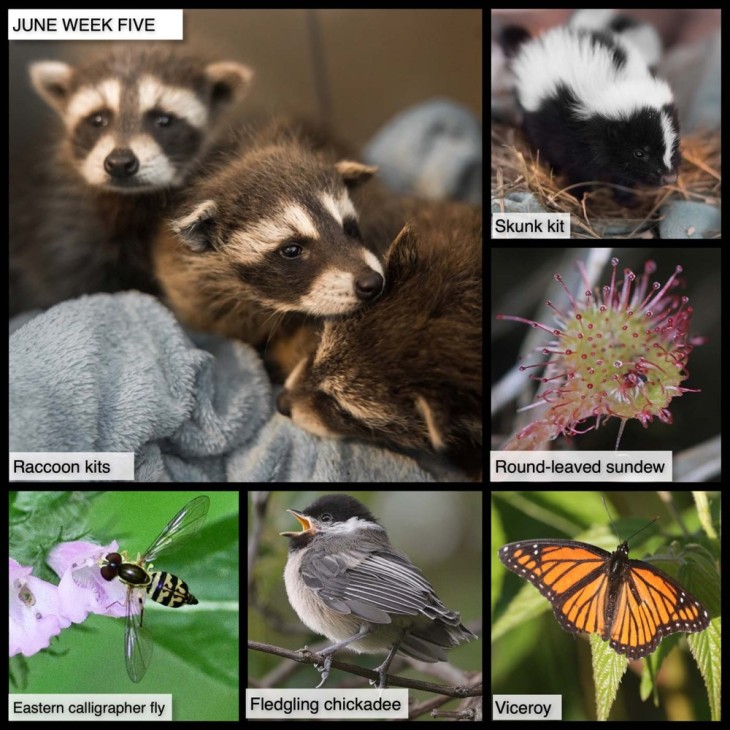This Week in the Woods, we’re giving a special shout out to the Thurston family, who jumped into action to rescue raccoon kits after their mother was hit by a car. After a cross-Vermont road trip (including a Starbucks drive-through in which the barista politely pretended not to notice loud chittering from the backseat), the young raccoons are safely in the hands of a state licensed wildlife rehabilitator, who will raise them until they’re ready to be released back into the woods. Now is peak season for baby animals, and wildlife rehabilitators are busy caring for many orphans, typically doing this work on a volunteer, self-funded basis. Here’s an Outside Story article by Meghan McCarthy McPhaul describing raccoon family life. If you do find a baby mammal that’s clearly in distress, never touch it with bare hands, and contact a licensed wildlife rehabilitator in your state (found through a web search) to figure out what you should do.
Here are some other nature sights this week (clockwise):
While delivering the raccoons, we also had the opportunity to see skunk kits. As noted in this profile from Vermont Fish and Wildlife, skunks are born in late spring, and stay with their mothers through summer, dispersing in fall.
If you’re near a bog or fen, keep an eye out for tiny round-leaved sundews. You’ll need magnification to fully appreciate the weird structure of these carnivorous plants. As noted by Frank Kaczmarek in this recent Outside Story essay, the “tiny drops of what looks like glistening dew” on the plant’s hair-like structures are actually “mucilage, a thick, sticky material that traps prey.” As the trapped insect struggles to free itself, the hairs curl inward, further imprisoning it. The plant then slowly digests the soft parts of the insect, and after a week or two, “the undigested exoskeleton is all that remains of the hapless victim.” In the photo, you can see the dark body of an insect, perhaps a gnat.
We were excited to see an early monarch butterfly in our field… but then looked more closely, and realized it wasn’t a monarch but a battered viceroy, perhaps the survivor of a bird encounter. Ways to tell that this insect isn’t a monarch is the black line crossing each back wing (only faintly appearing on this butterfly), the size (the viceroy is smaller), and subtle differences in stripes and spots. Viceroys have traditionally been described as Batesian mimics of monarchs – in other words, species that have evolved to resemble other species in a way that deters predators. However, research suggests that viceroys, like monarchs, have chemical defenses and may therefore be – wait for it – “müllerian co-mimics.” Here’s a link to an abstract about this research from the journal Nature.
While many young birds aren’t out of the nest yet, you can now see black-capped chickadee fledglings in trees and shrubs, and you can probably hear them, too, complaining loudly to their parents that they want more food now. Notice that the bird in the photo is flashing a bright yellow bill and has still-stubby wing and tail feathers – all signs that this is a fledgling. Despite getting an earlier start on breeding season than many birds, chickadees typically only have one brood a year. Here’s a profile from The Cornell Lab’s All About Birds site.
We found this eastern calligrapher fly deep in the woods, nectaring on wild basil. The eastern calligrapher is a common native pollinator of the Northeast, and a member of the bee/wasp-mimic Toxomerus hoverfly group, described here in iNaturalist. Unlike the viceroy described above, this is a true Batesian mimic, and despite its intimidating looks, it can’t sting. Note the distinctive head and short antennae that help give it away as a fly. Here’s an Outside Story essay by Joe Rankin that discusses hoverflies and describes a disturbing entomologist party trick involving hoverfly that resembles a bald-faced hornet.
Our thanks to The Bailey Charitable Foundation and the Frank and Brinna Sands Foundation for helping to support this series.
In this difficult period, many of us find joy in observing local nature. This series, launched in April 2020, shares nature photographs taken in the past seven days, or in the same week in 2020, most within 15 miles of the Northern Woodlands office in Lyme, New Hampshire. We hope you enjoy using this grid as a prompt for your own explorations.
What are you seeing in the woods this week? Share your images with us on Facebook, or submit a special photo for possible inclusion in our monthly online Reader Photo Gallery.


